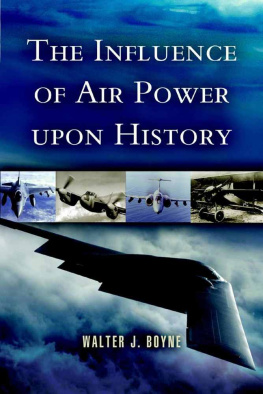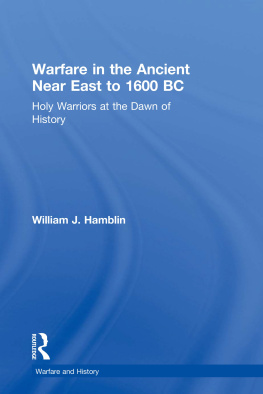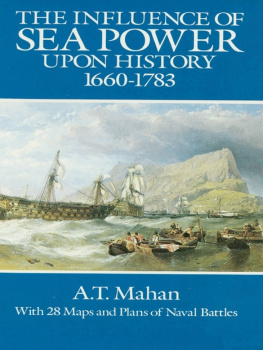Also by Walter J. Boyne
The Two OClock War
Aces in Command
Brasseys Air Combat Reader
(with Philip Handleman)
Beyond the Horizons: The Lockheed Story
Beyond the Wild Blue,
A History of the USAF, 1947-1997
Clash of Titans
Clash of Wings
Silver Wings
Art in Flight
Classic Aircraft
Gulf War
Weapons of Desert Storm
Power Behind the Wheel
The Smithsonian Book of Flight
The Wild Blue
(with Steven Thompson)
The Leading Edge
Trophy for Eagles
Eagles At War
Air Force Eagles
Phantom in Combat
Boeing B-52: A Documentary History
Messerschmitt Me 262: Arrow to the Future
Air Warfare, An International Encyclopedia
(editor)
The Influence of Air Power Upon History
Walter J Boyne
This 2nd edition first published in Great Britain in 2005 by
PEN & SWORD AVIATION
an imprint of
Pen & Sword Books Limited
47 Church Street
Barnsley
South Yorkshire
S70 2AS
Copyright Walter J. Boyne, 2005
9781783409563
First edition published in 2003
by the Pelican Publishing Company, Inc, Louisiana, USA
The right of Walter J. Boyne to be
identified as Author of this Work has
been asserted by him in accordance with
the Copyright, Designs and Patents Act 1988.
A CIP catalogue recordfor this book
is available from the British Library.
All rights reserved. No part of this book may be reproduced or transmitted in any form or by any means, electronic or mechanical including photocopying, recording or by any information storage and retrieval system, without permission from the Publisher in writing.
Printed and bound in Great Britain by
CPI UK
Pen & Sword Books Ltd incorporates the imprints of
Pen & Sword Aviation, Pen & Sword Maritime, Pen & Sword Military,
Wharncliffe Local History, Pen & Sword Select,
Pen & Sword Military Classics and Leo Cooper.
For a complete list of Pen & Sword titles please contact:
PEN & SWORD BOOKS LIMITED
47 Church Street, Barnsley, South Yorkshire, S70 2AS, England.
E-mail: enquiries@pen-and-sword.co.uk
W ebsite: www.pen-and-sword.co.uk
This book is dedicated to the airmen and airwomen of all nations.
Table of Contents
Acknowledgments
Writing this book has been a great pleasure, and I am indebted to the many people who made it possible. It is only fitting that the first persons to be acknowledged are Kenneth S. Giniger, who suggested that the book be written, and Dr. Milburn Calhoun, of Pelican Publishing, who undertook to publish it. My fine agent, Jacques de Spoelberch, collaborated with these two men to work out the contractual details.
In the research and writing, I turned to many colleagues for information, analysis, and ideas. I am grateful for the many valuable suggestions made by Dr. William F. Trimble in his thorough review of the manuscript; he gamely endured my many writing gaffes with patience and good humor. Auburn University doctoral candidate Bert Frandsen also reviewed the entire manuscript and gave me many insightful tips. Dr. Phillip Meilinger sent me much valuable material, for which I am most grateful. Dr. W. David Lewis also pointed me to some excellent resources. Dr. William M. Leary was very helpful.
I sent many of the chapters to specialists in the field, and to authors and experts such as Gregory Alegi, August Blume, Warren Bodie, Peter Bowers, Donald Caldwell, Howard Fisher, George Mellinger, Stphane Nicolaou, Lon Nordeen, Lee Payne, James Streckfuss, Guillaume de Syon, Spencer Tucker, George Watson, and Mark Witzel. All were most responsive, providing many excellent suggestions for correcting my sins of omission and commission. Philip Handleman took time from his busy schedule to review the manuscript; his insight, as always, was invaluable. Wally Meeks not only made his usual good suggestions, he also provided some of the most valuable research material. Richard de Angelis, Susan Fischer, and David Rezelman all contributed material via Air Warfare: An International Encyclopedia .
To everyone, my thanks; if I have forgotten anyone, please forgive me, and know that I am grateful, if forgetful.
Introduction
It was with no little trepidation that I chose to use a title so closely matching that of one of the most important military books of its time, Alfred Thayer Mahans Influence of Sea Power upon History, 1660-1783. As the following pages will reveal, it is not my intent directly to compare Mahans ideas on sea power with ideas on air power, nor to make obvious every parallel that could be inferred from reading both books.
Instead, the present work is intended to look into the development of air-power philosophy over its history by examining the theory and practice of air power as demonstrated not only in war, but also in politics, diplomacy, technology, and mass culture. To do so necessarily involves recounting the history of air power on a selective basis, choosing as examples historic events that demonstrate the influence of air poweror in some instances, the failure of air powerto influence events.
There is a considerable body of literature on air power, much of which is centered on arguments as to whether air power is or is not decisive in warfare. These arguments will be examined on their merit, but the principal thrust of the book is implicit in its title, that is, the influence of air power on history. From a surprisingly well organized if comparatively small beginning in the early days when balloons defined air power, this influence has grown from being considerable in World War I to tremendously important in World War II and thereafter. The concept of whether or not air power was or was not decisive in any particular situation will be dealt with as required, but it is important to repeat that the influence of air power extends far beyond war or the threat of war. I believe the reader will find that the influence of air power has in many instances been far more important than any question of its decisiveness in battle, for it has affected the direction of national policies, the growth of industries, and perhaps most important, the rapid advance of technology, even in times of peace.
This is fortunate, for questions about both the influence and the decisiveness of air power were never more important than today, when the world is faced with an entirely new kind of terrorist-driven war-making, with new kinds of enemies, shadowy groups of warped individuals who murder in the guise of religion. These new enemies have converted their weakness in numbers and arms into the terror of an especially depraved concept of asymmetric warfare in which the killing of innocents of any nation is substituted for meeting the warriors of an enemy state in battle. Neither air power advocates nor naysayers ever anticipated the sheer perversity of the terrorists attacks, from bombing kindergartens to crashing highjacked airliners into buildings to the threat of using weapons of mass destruction in cities around the world.
These challenges will be met in the future, just as other new challenges of conventional or unconventional threats were met in the past. As a single example, the British responded to the totally new threat presented by Zeppelins and bomber aircraft during World War I, which, as we will see, brought terror to the populace and changes in force disposition to the military. Then, one war later, the British used many of the ideas developed in that early response to ward off what time and usage had converted to the conventional German bombing attack during World War II. These ideas included the use of early warning systems, a ground observer corps, audio direction finding (that was replaced by radar direction finding), and a centralized command and control of defensive air power.
Turning for the time being from this ultimate horror, it should be noted that this book also focuses extensively on the influence of personalities on air power, and thus their influence on history. There were marvelously gifted leaders in sea warfare, from before Nelson until after Nimitz, but there have been relatively few evangelists of sea power. The reason, perhaps, was that sea power was so much a given that it took a Mahan to reveal the full measure of its importance. Advocates of air power, in contrast, had to struggle to get their ideas across, often choosing a message so stridently optimistic that their credibility was inevitably lost. There emerged many forceful, articulate, and, it must be said, widely divergent personalities, attempting both to define and direct air power. This came about in part because practitioners of air power by their very nature are forceful individuals and in part because the technology of air power changed so swiftly over time.
Next page







